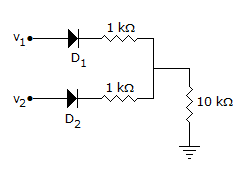Electronics and Communication Engineering - Analog Electronics - Discussion
Discussion Forum : Analog Electronics - Section 1 (Q.No. 7)
7.
In figure v1 = 8 V and v2 = 4 V. Which diode will conduct?


Answer: Option
Explanation:
D1 will conduct and the output voltage will be about 7 V. Therefore D2 will be reverse biased and will not conduct.
Discussion:
32 comments Page 1 of 4.
Aatif Khan said:
5 years ago
Option B is correct.
First, consider both the diodes forward bias.
Then with the help of nodal analysis find the voltage at junction 1k,1k and 10k.
{((V-8)/1k) +((V-4)/1k)+(V/10k)} = 0.
On solving the above equation we get, V = 5.71v.
Given that V1=8v and V2=4v which are positive terminal voltage for D1 and D2 respectively
for both diodes, we have a negative terminal voltage V=5.71v.
So D1 will conduct because Vp>Vn (condition for forwarding bias) (Vp=8v, Vn=5.71v)
D2 will not conduct because Vp<Vn (condition for reverse bias) (Vp=4v, Vn=5.71v).
First, consider both the diodes forward bias.
Then with the help of nodal analysis find the voltage at junction 1k,1k and 10k.
{((V-8)/1k) +((V-4)/1k)+(V/10k)} = 0.
On solving the above equation we get, V = 5.71v.
Given that V1=8v and V2=4v which are positive terminal voltage for D1 and D2 respectively
for both diodes, we have a negative terminal voltage V=5.71v.
So D1 will conduct because Vp>Vn (condition for forwarding bias) (Vp=8v, Vn=5.71v)
D2 will not conduct because Vp<Vn (condition for reverse bias) (Vp=4v, Vn=5.71v).
(7)
Nikkie said:
9 years ago
First take: I(1) + I(2) = I.
where I(1) = (V-8)/1k ohm.
similarly I(2) = (V-4)/1k ohm.
And I = V/10k ohm.
Next solve for 'V' ( USING KCL AT NODE V).
You will get V = 40/7 which is 5.7 something.
Hence, d1 will conduct and d2 will be reverse bias and won't conduct.
where I(1) = (V-8)/1k ohm.
similarly I(2) = (V-4)/1k ohm.
And I = V/10k ohm.
Next solve for 'V' ( USING KCL AT NODE V).
You will get V = 40/7 which is 5.7 something.
Hence, d1 will conduct and d2 will be reverse bias and won't conduct.
Naveen said:
7 years ago
After Diode D1 conducts the potential creat at the junction between 1k and 10k is 6.36V (assume both diodes are Silicon diode) so at the diode, D2 anode potential is lesser than the cathode potential so D2 will not conduct.
So, Answer B is the right answer.
So, Answer B is the right answer.
Shivanand said:
10 years ago
The diode which experiences the maximum potential differences between the two nodes, that diode will conduct. As in this case between v1 and ground Diode D1 experiences the potential difference of 8v but D2 experiences only 4v. So the diode D1 conducts.
Raushan said:
9 years ago
Assume both diodes are in forward bias, then after doing node analysis, the node at the intersection of 3 resistors, has the potential of 5 V (assuming cut off voltage 0.7V), which contradicts, so only one diode is in forward bias.
Mukkiii nautiyal said:
8 years ago
Simple apply kcl at the node.
V-8+v-4=v/10,
2v-12=v/10,
20v-120=v,
19v=120,
V=120/19,
V=6.31v.
You will get 6.31v at that node. So diode D1 is FB and D2 is Rb.
The answer should be B.
V-8+v-4=v/10,
2v-12=v/10,
20v-120=v,
19v=120,
V=120/19,
V=6.31v.
You will get 6.31v at that node. So diode D1 is FB and D2 is Rb.
The answer should be B.
Neha said:
8 years ago
@Nikkie
You will get V = 40/7 which is 5.7.
Hence, d1 will conduct and d2 will be reverse bias and won't conduct.
But from above statement how can tell that d1 will conduct?
You will get V = 40/7 which is 5.7.
Hence, d1 will conduct and d2 will be reverse bias and won't conduct.
But from above statement how can tell that d1 will conduct?
Artigo said:
7 years ago
@KCL.
i total = i1 + i2.
(V-8-0.7)/1k + (V-4-0.7)/1k = V/10k.
V = 7.05 so only D1 will conduct since it exceeds the threshold 7.05 and D2 is reverse biased.
i total = i1 + i2.
(V-8-0.7)/1k + (V-4-0.7)/1k = V/10k.
V = 7.05 so only D1 will conduct since it exceeds the threshold 7.05 and D2 is reverse biased.
Vikesh said:
1 decade ago
B is correct answer. First you suppose that both are forward biased and then find out the voltage at node. You will see that diode D2 will reverse biased.
Yussuf said:
5 years ago
i total = i1 + i2.
(V-8+0.7)/1k + (V-4+0.7)/1k = V/10k.
V = 5.05 so only D1 will conduct since it exceeds the threshold 5.05 and D2 is reverse biased.
(V-8+0.7)/1k + (V-4+0.7)/1k = V/10k.
V = 5.05 so only D1 will conduct since it exceeds the threshold 5.05 and D2 is reverse biased.
(2)
Post your comments here:
Quick links
Quantitative Aptitude
Verbal (English)
Reasoning
Programming
Interview
Placement Papers